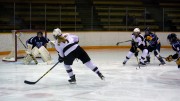Lauren Taraschuk’s personal mantra may be “get a little better every day,” but as the old sports maxim goes: “You can’t teach size.”
Currently listed at six-foot, the Winnipeg-born netminder stands well above the average for both men and women in the general Canadian population. Further, she — quite literally — stands head and shoulders above every other netminder in Canada West.
This height, and the advantages that come along with it, goes a long way toward explaining how she has quickly become one of the nation’s top goaltenders. Taraschuk won a national championship as a rookie, and had a conference best 0.71 goals-against-average and second-best 0.961 save percentage.
However her height also provides plenty of issues that teams like the University of Alberta Pandas — currently occupying first-place in Canada West — are ready to exploit.
Advantages: Mobility and angle coverage
When facing down a shot, a major determinant of success on the part of the goaltender is covering as much of the net as possible. The less open space you give the shooter, the lower the chance they have of putting the puck in that area.
Of course, there are shooters out there who can pick those corners and gaps but, in women’s hockey, Taraschuk is in a class of her own.
When most female netminders drop low to the butterfly — or even drop into their ready stance — the area over their shoulders is exposed. Along with this is a lack of width in the torso, necessitating greater arm movement to cover shots going laterally.
Taraschuk, on the other hand, covers between five to seven inches more vertical space, still touching the crossbar when she’s down low. This imposing figure covers more net and requires more skilled shooters to get the puck behind her.
The obvious solution to this is cross-crease and cross-ice passes, forcing Taraschuk to move laterally and expose more net. However, again her height compensates.
Not only does she already cover more space than the average women’s hockey goaltender, a lot of her height comes from her legs. Taraschuk is able to move laterally much quicker than other goalies, owing primarily to her strides being longer. Toss in a good glove hand and blocker, and she is nigh unbeatable.
Disadvantages: More size, more to move
While Taraschuk’s height may be a boon in some respects, as can be seen with tall male goaltenders such as Ben Bishop and Connor Hellebuyck, there are literal cracks to be exploited.
The length of one’s limbs does not necessarily translate to the width of said limbs. While Taraschuk can extend her limbs out to make saves, this extension does not help shots going below her arms and pads.
More effort than average is needed by larger goaltenders to move their limbs vertically to stop pucks. This was on full display for Taraschuk against the University of Alberta on Jan. 4.
Down 2-0, Autumn MacDougall picked up a headman pass and went in on a partial break. She snapped a shot, sneaking it just below Taraschuk’s left knee to make it 3-0 Alberta. In that moment, Taraschuk’s height hurt her.
With a much longer leg, more time and energy were needed to close that angle and drop to the ice. More energy needed to move a larger object. Large goaltenders have more trouble with lower saves because they need to move more physical mass to cover those areas.
This same principle exists with all left-catching goaltenders facing left-handed shooters — and the same for those on the right. A shot low blocker is hard to stop because the blocker itself is so heavy. However, for Taraschuk and other tall netminders, the problem is exacerbated by the overall increase in area under the arms.
The solution to this comes down to her team’s defence. If they can force shots from further out, this will give Taraschuk more time to see and react, saving her the hundredth of a second needed to get in the way.
Taraschuk has seen a statistical decline this season, which you could argue is due to a Bisons squad missing key veterans from last season. Further, with another year in the league, teams can plan to face her more effectively.
That being said, with a 1.50 goals-against-average and 0.938 save percentage so far in the 2018-19 season, Taraschuk is looking far from solved by her opponents.





